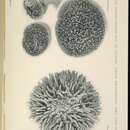Biology
provided by Arkive
Heliofungia corals can reproduce sexually or asexually. During sexual reproduction, eggs and sperm are released into the water, where the fertilized egg develops into larvae. Within a fortnight, the larvae will settle on to hard substrate. Asexually reproduced young coral, or acanthocauli, can develop from partly buried, damaged or dying parent tissue. Either way, the result is a vase-shaped polyp that gradually grows into a flattened disc, attached to the substrate via a stalk. The stalk of the 'mushroom' eventually dissolves, and the coral becomes mobile. The newly mobile coral rests on the bottom where it will mature and reproduce (2) (3).
Heliofungia have microscopic algae (zooxanthellae) living within their tissues. Through photosynthesis, these symbiotic algae produce energy-rich molecules that the coral polyps can use as nutrition. In addition, the large polyps can use their long tentacles to capture prey (4)
Conservation
provided by Arkive
Heliofungia corals are listed on Appendix II of the Convention on International Trade in Endangered Species (CITES), which means that trade in this species should be carefully regulated (1). Indonesia and Fiji have export quotas in place for this species (1). Heliofungia corals will form part of the marine community in many marine protected areas (MPAs), which offer coral reefs a degree of protection, and there are many calls from non-governmental organisations for larger MPAs to ensure the persistence of these unique and fascinating ecosystems (5).
Description
provided by Arkive
Rather than forming colonies like most other corals, this mushroom coral is solitary and free-living; that is, it is not attached to the substrate (except for juveniles). The coral is flat with a large central mouth. The soft tissue surrounding the mouth is striped. The long dark purple or green tentacles with pale tips are extended day and night, and are similar to those of giant anemones. Very young Heliofungia (called acanthocauli) bear little resemblance to the adult form; they are shaped like flattened discs and are attached to the substrate via a stalk. Their resemblance to mushrooms gives these corals their common name. Heliofungia actiniformis used to be considered part of the Fungia genus, however, whilst the skeletons and habitat are very similar, they differ in their polyp structure (2).
Habitat
provided by Arkive
Usually found on flat, soft or rubble substrates especially in reef lagoons or shallow turbid environments (2).
Range
provided by Arkive
Occurs around Indonesia, the Philippines and Australia (3).
Status
provided by Arkive
Listed on Appendix II of CITES (1).
Threats
provided by Arkive
Heliofungia corals face the many threats that are impacting coral reefs globally. It is estimated that 20 percent of the world's coral reefs have already been effectively destroyed and show no immediate prospects of recovery, and 24 percent of the world's reefs are under imminent risk of collapse due to human pressures. These human impacts include poor land management practices that are releasing more sediment, nutrients and pollutants into the oceans and stressing the fragile reef ecosystem. Over fishing has 'knock-on' effects that results in the increase of macro-algae that can out-compete and smother corals, and fishing using destructive methods physically devastates the reef. A further potential threat is the increase of coral bleaching events, as a result of global climate change (5). Harvesting of corals may also pose a threat to Heliofungia. This species is one of the top ten species in the live coral trade, as its large, colourful polyps make it a desirable species in aquariums (6). However, it has a poor survival record in aquarium conditions as it is very sensitive (7), and therefore it may be need to be replaced frequently, resulting in greater demand for harvesting than other, more robust species.

